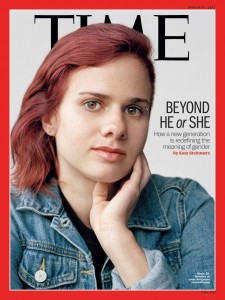Beyond ‘He’ or ‘She’
< < Go Back
A growing number of young people are moving beyond the idea that we live in a world where sexuality and gender come in only two forms.
In Park City, Utah, students are lining up at a local high school to get their locker assignments for the semester. Extracurricular clubs have set up tables to attract new members. It’s only midday, but the Gay-Straight Alliance, a group with outposts at about a quarter of American secondary schools, already has 47 names on its sign-up sheet. Sitting behind piles of rainbow-colored paper cranes — a hot fundraising item — the group leaders are counting the different identity labels they’ve encountered. Sure, there’s lesbian, gay, bisexual, transgender. But there are more. Way more. “There are people who are pan,” says 17-year-old club president Grace Mason, meaning pansexual. There’s also aromantic, asexual, genderqueer, two-spirit and on and on.
Hyperindividual, you-do-you young people from across the U.S. are upending the convention that when it comes to gender and sexuality, there are only two options for each: male or female, gay or straight. These aspects of identity — the sense of being a man or a woman, for instance, and whom one is drawn to physically or romantically — are distinct. But they are related, and together, they’re undergoing a sea change, as an increasing number of people say they aren’t one or the other but perhaps neither or maybe both.
As many transgender people fight for equal status as men and women in society — with identities that feel just as static as anyone else’s — others say their feelings about gender don’t fit in either of those boxes and might change over time. “Some days I feel like my gender could be like what I was assigned at birth, but there are some days when I feel the opposite way,” says Rowan Little, an 18-year-old high school senior in Kentucky who identifies as gender fluid and uses the pronoun they, rather than he or she. Young people are pointing to the middle in terms of sexual attraction too, with one survey finding that nearly a third of young Americans see themselves somewhere between 100% heterosexual and 100% homosexual.
More From TIME Magazine:




